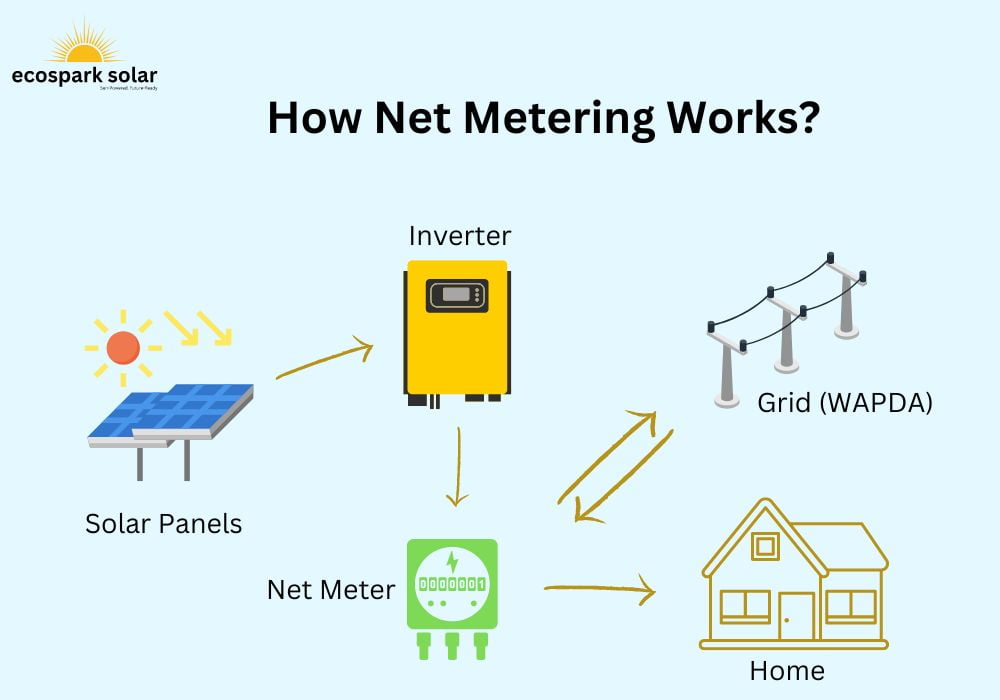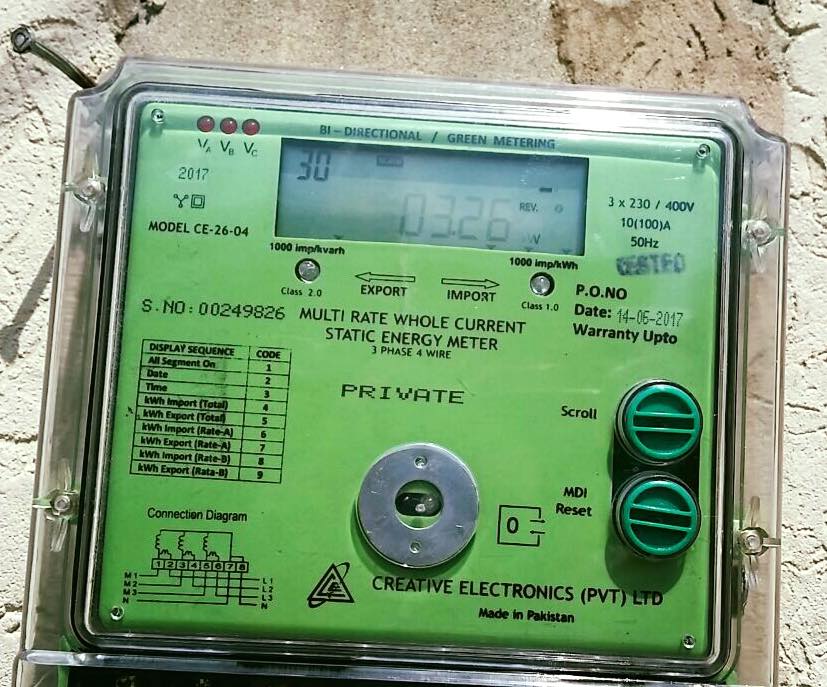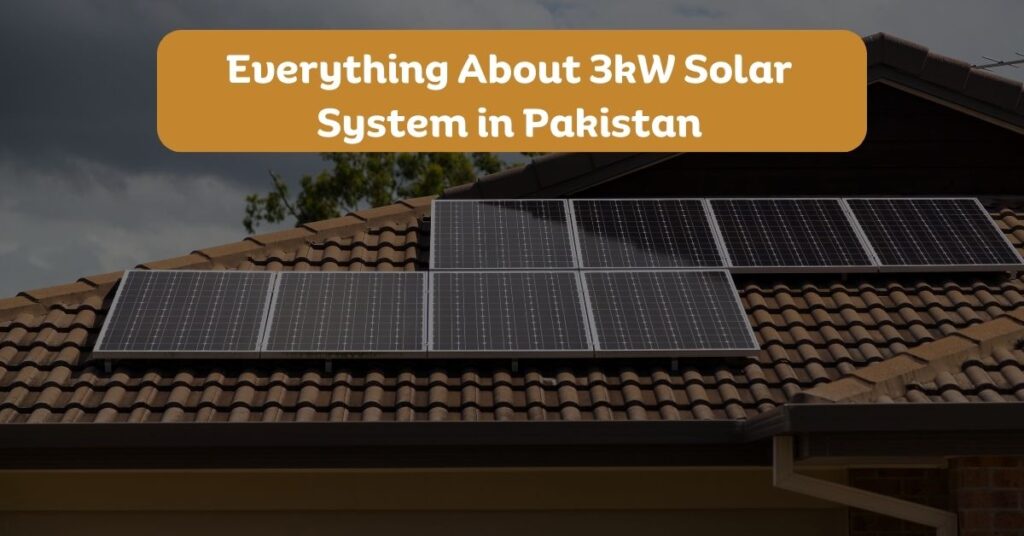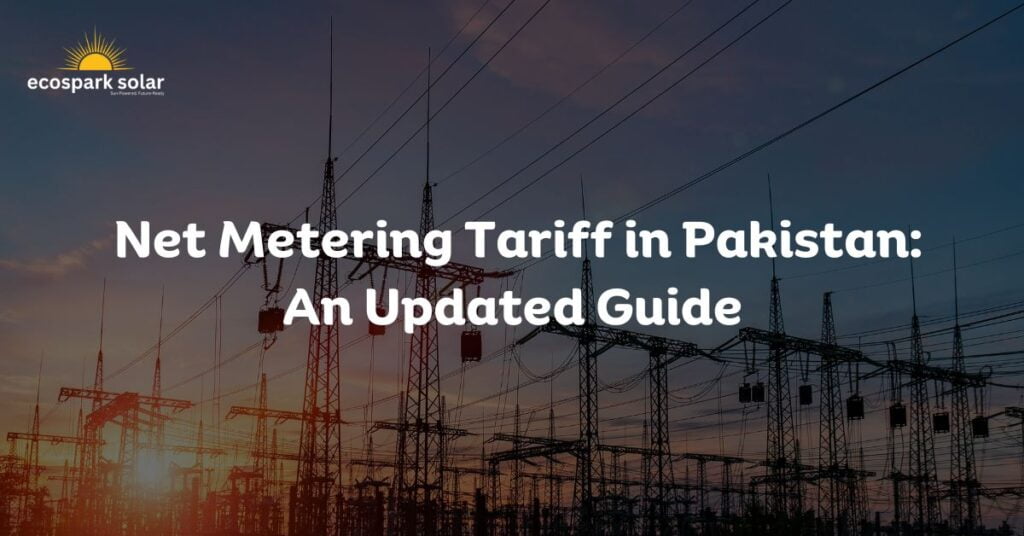Pakistan’s energy landscape has long been beset with challenges such as inadequate supply, rising costs, and heavy reliance on fossil fuel-based sources. Pakistan also regularly experiences power outages, which not only interrupt daily life but also hold back economic development and growth. With the demand for electricity increasing exponentially, it becomes critical to find innovative and sustainable solutions in order to bridge this widening energy gap.
In this context, net metering represents a beacon of hope for Pakistanis: It offers a way out, relieving pressure off the national grid while giving individuals and businesses more control of their energy use. Net metering presents an empowering mechanism that allows consumers to generate their own electricity through solar panels, thus decreasing dependence on conventional sources and relieving pressure on an already overburdened power infrastructure.
In this article, we delve into the concept of net metering in Pakistan, highlighting its significance in the country’s energy landscape.
We will explore:
- What is net metering?
- How does net metering work in Pakistan?
- Who regulates and implements the net metering framework in Pakistan?
- What are the eligibility criteria for net metering in Pakistan?
- The application process
- How are you compensated for extra units earned through net metering?
- How can net metering benefit Pakistani households and businesses?
Let’s start with the basics.
Understanding Net Metering
Net metering is a mechanism that enables consumers to generate electricity from renewable sources such as solar panels or wind turbines and send any excess power that they produce back into the grid to offset their energy usage.
Net metering works on a straightforward principle:
When a consumer’s solar power system generates more electricity than they need, the excess electricity is automatically sent back into the grid and then credited back into their account, effectively shifting their electricity meter backward.
At other times, however, when their production falls below their demand, they draw energy from the grid, as usual.
Net metering’s hallmark feature is its “net” component, which measures the difference between energy consumed from and exported back to the grid. Customers are only charged for “net” electricity consumed—that is, energy consumed minus energy produced.
In this sense, it offers individuals and businesses alike an opportunity to become active participants in energy generation, not only reducing reliance on conventional power sources but also contributing clean, green energy back into the grid.
In the following sections, we will delve deeper into how net metering works in the context of Pakistan, the stakeholders involved, and the policy and regulatory framework that governs its implementation.
How Net Metering Works in Pakistan?
Net metering in Pakistan operates under a well-defined policy and regulatory framework, which provides the guidelines and mechanisms for its implementation. The regulatory authority overseeing net metering in the country is the National Electric Power Regulatory Authority (NEPRA).
In 2015, NEPRA introduced the Net Metering for Renewable Energy Systems Regulations, which set the groundwork for net metering implementation. These regulations outline the eligibility criteria, technical requirements, and billing mechanisms for consumers participating in net metering programs.
According to the NEPRA regulations, net metering is available for domestic (residential), commercial, industrial, and agricultural consumers who install renewable energy systems with a capacity between 1kW and 1 MW. Renewable energy sources include solar, wind, biomass, and hydro.
Under the net metering policy, Distribution Companies (DISCOs), such as IESCO, LESCO, PESCO, KE, MEPCO, etc., play a crucial role in facilitating the implementation process. DISCOs are responsible for evaluating applications, inspecting renewable energy systems, and installing the bidirectional meter that measures the energy imported from and exported to the grid.
Once the net metering system is installed, the DISCOs are responsible for monitoring and recording the electricity consumption and export. They calculate the net energy consumed and bill the consumer accordingly. If the consumer generates more electricity than they consume in a billing period, the surplus is carried forward as a credit to offset future electricity bills.
NEPRA’s net metering policy promotes a favorable environment for consumers to invest in renewable energy systems and benefit from the associated financial incentives. It encourages the growth of a sustainable energy market in Pakistan and supports the country’s overall energy goals.

A solar system for everyone.
We’re customer-centric; we will find you a solution within your budget. Whatever your project size, you can always save with Ecospark Solar.
Eligibility Criteria for Net Metering in Pakistan
You can avail the benefits of net metering only if you meet the following criteria.
- You are installing a system for residential, commercial, industrial, and agricultural use. It basically covers all the sectors, so most consumers would qualify.
- The renewable energy system’s capacity should be at least 1 kilowatt and must not exceed 1 MW.
- The consumer must have 3 3-phase 400V connection. Some consumers who don’t have 3-phase connections may apply for a 3-phase connection before applying for net metering.
- The consumer must have a valid and active electricity connection from the Distribution Company (DISCO). Again, most consumers would qualify.
- The consumer should own or have a long-term lease agreement for the premises where the renewable energy system is installed.
- The renewable energy system should comply with technical standards and requirements set by the National Electric Power Regulatory Authority (NEPRA).
For example, the grid-connected inverters shall comply with the UL 1741 standard, which addresses the electrical interconnection design of various forms of generating equipment. Other standards that the DG facility should adopt to are IEEE 1547 2OO3 (standard of interconnecting distributed resources with electric power system), IEC 61215 for crystalline PV modules, and IEC 61646 for thin film PV modules.
- The consumer must obtain all necessary permissions and approvals from relevant authorities, including the DISCO and NEPRA. You do not have to worry about that—your solar installer will take care of it.
- The consumer is responsible for ensuring that the renewable energy system is installed by an accredited and certified installer.
- The consumer must comply with safety regulations and obtain the required certifications for the renewable energy system.
- The consumer must sign a net metering agreement with the DISCO, outlining the terms and conditions for participating in the net metering program.
It is important for consumers interested in net metering to review the specific guidelines and requirements provided by the respective DISCO and follow the application process outlined by the regulatory authorities. Adhering to the eligibility criteria ensures smooth and compliant participation in the net metering program in Pakistan.
| You May Want to Read: IESCO Net Metering Guide |
How Are You Compensated for Net Metering in Pakistan?
In Pakistan’s net metering program, consumers who participate in the scheme are compensated for the surplus electricity they generate and feed back into the grid. The compensation mechanism ensures that consumers receive fair value for the excess energy they contribute.
Under the NEPRA’s net metering rules, the compensation is primarily based on the concept of “net energy billing.” This means that consumers are billed for the net electricity consumed from the grid, which takes into account both the electricity imported and exported.
Let’s simplify how the process of net metering works in Pakistan:
1. Billing Calculation
The Distribution Company (DISCO) measures the electricity consumed by the consumer and the electricity exported to the grid using a bidirectional meter. This meter records the energy flow in both directions accurately.
2. Net Energy Calculation
The DISCO calculates the net energy consumed by subtracting the exported energy from the imported energy during the billing period. The net energy is the electricity consumed by the consumer after accounting for the excess electricity generated.
3. Billing Adjustment
The consumer is billed only for the net energy consumed from the grid. If the consumer generates more electricity than they consume during the billing period, the surplus energy is carried forward as a credit.
4. Credit Utilization
The credit accumulated from the surplus energy can be used to offset future electricity bills. It is applied against the consumer’s future net energy consumption, reducing the amount payable to the DISCO.
If you produced more than you consumed, the credit will be carried forward to the next month. If the next month, the credit will be rolled forward again. After three months, when the exported energy is more than the energy you used, you will be compensated for the excess electricity.
5. Tariff of Net Metering in Pakistan
At the moment, the tariff for net metering in Pakistan is Rs. 10/kWh, as per the NEPRA rules. In the last quarter of 2022, the NEPRA considered reducing the tariff to Rs. 9/kWh, but it was strongly opposed by civil society, stakeholders, and solar activists. Consequently, they decided against revising the tariff. However, the government moved ahead with the plan in March 2025, as reported by Sama News.
“Under the new policy, the government will purchase electricity from net metering consumers at Rs 10 per unit instead of the previous Rs 27 per unit, Federal Minister for Power Sardar Awais Ahmed Khan Leghari confirmed.
The minister also reiterated that there will be no tax on the electricity units exported to the grid by solar net metering users. However, they will continue to pay an 18% sales tax on the electricity they consume from the grid, similar to other consumers.
The changes in the net metering policy, approved by the Economic Coordination Committee (ECC), aim to create a balanced tariff structure while encouraging solar energy adoption.”
When considering the buyback price of electricity, it is pertinent to mention that the DISCOs buy electricity back at off-peak rates. Off-peak rates are low compared to peak-hour rates. Irrespective of at which moment you send electricity back to the grid, you will be compensated at the off-peak rate.
It is also important to note that the specific compensation mechanism may vary slightly among different DISCOs or as per the applicable regulations. Therefore, consumers should review the terms and conditions of their net metering agreement to understand the compensation structure and billing process specific to their DISCO.

The Application Process for Net Metering in Pakistan
1. Preparing Documentation
Begin by gathering the necessary documentation required for the net metering application. This typically includes identification documents, proof of ownership or a long-term lease agreement for the premises, and a copy of the latest electricity bill.
2. Selecting an Accredited Installer
Engage a certified and accredited installer for the renewable energy system installation. Ensure that they have the necessary expertise and experience in setting up the specific type of system you plan to install.
3. Technical Evaluation
The Distribution Company (DISCO) will conduct a technical evaluation of the proposed renewable energy system. This evaluation ensures that the system meets the technical requirements and safety standards set by the National Electric Power Regulatory Authority (NEPRA). The DISCO may visit the premises to assess the feasibility and compliance of the installation.
4. Application Submission
Submit the completed net metering application to the DISCO along with all the required documentation. The application form can be obtained from the DISCO’s website or office. See the annexures of this document for application and agreement samples.
Ensure that all fields are accurately filled out and that all supporting documents are provided.
5. Application Review and Approval
The DISCO reviews the application and verifies the eligibility criteria, technical details, and compliance with regulations. This process may take some time, and additional information or clarification may be requested. Once the application is approved, the DISCO will provide an acceptance letter or notification.
6. Installation and Inspection
Upon receiving the approval, coordinate with the accredited installer to proceed with the installation of the renewable energy system. The DISCO will schedule an inspection to ensure that the installation meets the technical and safety requirements outlined in the net metering regulations.
7. Meter Installation
The DISCO will install a bidirectional green meter, as shown below, that accurately measures the imported and exported electricity. This meter allows for precise billing and calculation of the net energy consumed.

8. Agreement Signing
Before the net metering system becomes operational, the consumer must sign a net metering agreement with the DISCO. This agreement outlines the terms and conditions of participating in the net metering program, including billing, compensation, and responsibilities of both parties.
It is important to note that the application process may vary slightly among different Distribution Companies (DISCOs). Your installer will take care of it—but if you are planning a DIY, do visit the sub-divisional office of your DISCO to get an exact idea of the process.
Benefits of Net Metering
Net metering offers a range of significant benefits to both consumers and the overall energy landscape in Pakistan.
Here are some key advantages of implementing net metering:
1. Cost Savings
Net metering allows consumers to generate their own electricity, reducing their reliance on the conventional power grid. By offsetting their energy consumption with the surplus energy they produce, consumers can significantly lower their electricity bills over time. This leads to long-term cost savings and increased financial stability for households, businesses, and industries.
One of our customers, who has installed a 5kW solar system, has brought their bills to zero with net metering.
2. Return on Investment
Installing a renewable energy system for net metering can provide an attractive return on investment. The upfront investment in solar panels can be recovered through reduced energy bills and potential revenue from exporting surplus electricity. Over the system’s lifespan, consumers can benefit from a positive return on their initial investment.
3. Energy Independence
By sizing your solar system the right way, you can become energy self-sufficient. By generating your own electricity, you are less dependent on the fluctuating prices of traditional energy sources and are insulated from power outages and supply disruptions. This increased energy independence enhances the reliability and stability of the energy supply for consumers, especially for us, as power outages are frequent here.
4. Environmental Sustainability
One of the significant advantages of net metering is its positive impact on the environment. By promoting the use of renewable energy sources, such as solar and wind, net metering reduces reliance on fossil fuels, which contribute to air pollution and climate change.
5. Grid Stability and Efficiency
Net metering facilitates the integration of distributed energy generation into the existing power grid. The surplus electricity generated by net metering participants is fed back into the grid, contributing to overall grid stability and reducing strain on centralized power generation.
Net Metering in Pakistan: Concluding Thoughts
Summing up, net metering is an exciting opportunity for solar owners to generate some extra units and reduce their electricity bills. It not only helps you save on your monthly bills, but it also shortens the payback period of your solar system. While we have covered many things in this article, if you still want more information, contact us, and we will be happy to assist you.



